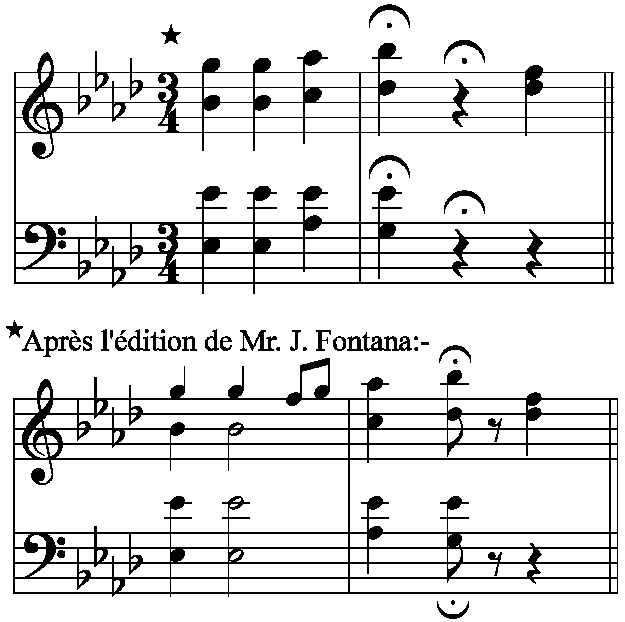Example 17.1-1.
#D<.C
.>;55.$ .$$7<>_6'.&"ID"FID777
.]$$;5$<>_6'.="ID"FID_6'&"ID"FID77<K

Variations in Print Type
17.1 Table 17 provides special signs (dots 56, 26 and dots 6, 26, respectively), to differentiate type size for facsimile transcription. When these signs are used, they are placed immediately before the note or interval to which they apply, and may be doubled (but see Par.17.3 (b)), only the second half of the sign being written twice.
Example 17.1-1.
#D<.C
.>;55.$ .$$7<>_6'.&"ID"FID777
.]$$;5$<>_6'.="ID"FID_6'&"ID"FID77<K

Example 17.1-2.
(See Par. 17.3 (a).)
#B4
.>'2.F+9;5-F+;59-F;5+9-.K
2;5.F"1.D+0.K.F;5+9-F+;59-<K

Example 17.1-3.
#D%
,55^\_:'D K D%J_I'(%%=HIH K
_)IF%F=FHG!HD,5E #C4 5_F"PE'Y<K

Example 17.3-1.
(Observe the difference between small notes and the short appoggiatura in Example 17.1-3 above.)
17.2. In non-facsimile transcriptions, when notes are written in small type to indicate deviation from normal rhythm, and yet they are not short appoggiaturas, the appropriate prefix should be used, as illustrated in Example 1.2-1 and 16.15-1. Example 17.1-3 illustrates the use of the small-type prefix in unmeasured music, where some degree of rhythmic latitude is taken for granted. However, where notes are shown in small type but there is neither rhythmic deviation nor unmeasured notation, or where the printer's purpose is merely to save space, the prefixes are not used and the size of the type is ignored in non-facsimile copy. (Thus the prefix would be omitted in Example 17.1-1 and 17.1-2 unless facsimile copy was requested.)
17.3. When the signs for large and small type are used for intervals, two important points must be remembered:
(a) If the written note in a chord (e.g. the fourth chord in Example l7.1-2 above) is a large or small note, it must be separated from the remaining notes of the chord by the in-accord sign to avoid the impression that the whole chord is similarly printed.
_>^?--JIHG-.K,5@F,5E"1^FE<K

(b) When these signs are used for intervals they can only be doubled if the intervals themselves are doubled.
Example 17.3-2.
#B4
.>.D-Z,55--&=HIJ,5- ;?-V<K

Variant Readings
17.4. When a passage is given in two or more versions in the print, the variants can either be placed as footnotes at the nearest convenient point in the braille text, or (in the case of very short instances) they can be joined to the text by the in-accord sign.
Example 17.4-1.
#D<#C4
.>'>59.\07[0 .W0<LV<L]+<K
_> _$-7[9 _\0<LV<LV<K
---------------------------
>59 ,APR@ES L'@EDITION DE
,MR4 ,J4 ,FONTANA3
.>.\0.K.\GH"1"T .[0J0<LX]+<K
_>_$-P- ''''''' _[9H0<LXV<K

Example 17.4-2.
#D%#D4
.>"J+9UT.PRJM*.Y+3J+9UT.PRJM"
%.Y#%-<>>OSSIA,55"W''+9*Y+3"
"W''+9,5%Y#%-<K

17.5. Another method which is sometimes used is to write the variant or variants immediately after the original passage preceded by the sign 5 placed before the first sign connected with the variant and followed immediately by the same indication after its last sign. If there are two or more variants, each is appropriately numbered, and if the passage contains more than one measure, the number of measures is placed after the first 5 in each variant.
Example 17.5-1.
#D4
"?A<:B?A*:B ?A<$B?A*$B<K
#A5#B"?B<:L?B*:L ?B<$L?B*$L<K5
#B5#B"?L<:1?L*:1 ?L<$1?L*$1<K5
#C5#B"?1<:K?1*:K ?1<$K?1*$K<K5

17.6. Notes or signs enclosed in parentheses in the print must be preceded and followed by the music parenthesis (Table 17).
Example 17.6-1.
#C4
.>"[+9[#0,'%,'\+0 "S'#-<K

(If the sharp in the above example had been printed above the note, either with or without parentheses, dot 6 (Table 5) would have been used, thus:
Example 17.6-2.
#C4
.>"[+9[#0,%\+0 "S'#-<K